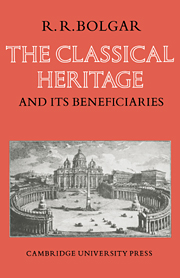Book contents
- Frontmatter
- Contents
- Preface to 1973 impression
- Introduction
- Chapter I The Background
- Chapter II The Greek East
- Chapter III The Carolingian Age
- Chapter IV The Pre-scholastic Age
- Chapter V The Scholastic Age
- Chapter VI Collapse and New Beginnings
- Chapter VII The High Renaissance
- Chapter VIII The End of the Renaissance and the Appearance of New Patterns in Classical Education and Scholarship
- Chapter IX Education and the Classical Heritage
- Notes
- Appendix I Greek MSS. in Italy during the Fifteenth Century
- Appendix II The Translations of Greek and Roman Classics before 1600
- Index
Chapter VI - Collapse and New Beginnings
Published online by Cambridge University Press: 29 January 2010
- Frontmatter
- Contents
- Preface to 1973 impression
- Introduction
- Chapter I The Background
- Chapter II The Greek East
- Chapter III The Carolingian Age
- Chapter IV The Pre-scholastic Age
- Chapter V The Scholastic Age
- Chapter VI Collapse and New Beginnings
- Chapter VII The High Renaissance
- Chapter VIII The End of the Renaissance and the Appearance of New Patterns in Classical Education and Scholarship
- Chapter IX Education and the Classical Heritage
- Notes
- Appendix I Greek MSS. in Italy during the Fifteenth Century
- Appendix II The Translations of Greek and Roman Classics before 1600
- Index
Summary
When Petrarch was crowned with laurel on the Capitol, the students of Paris were listening to Buridan's lectures on the pons asinorum. The event which was to serve future generations as the aptest symbol of the Renaissance coincided in time with the typical pursuits of Scholasticism; and by a similar paradox only three years separate the revolt of the Florentine popolo against Walter of Brienne from the battle of Crécy. The proper characterisation of the fourteenth century has therefore been a matter of dispute; and the question has been asked whether the epoch which produced both Ockham's razor and the Decameron belongs more typically to the end of the Middle Ages or the beginning of the Renaissance.
The historians who have sought to answer this question have commonly drawn attention to the dividing line of the Alps and presumed the existence of two distinct cultures, one to the south, the other to the north. We can, the argument runs, look upon the Renaissance as evolving in time. We can note how certain books were read, first by a few and then by many, how they were translated and interpreted, imitated and gradually absorbed into contemporary tradition. We can trace the history of techniques from their first introduction to their eventual acceptance as commonplace routines. We can follow the elaboration of particular ideas, which make their début as concepts in some specialised field and were then applied to other spheres of experience. We can note how the culture which we associate with the name of Petrarch became more complex and played a larger role in European life with each passing decade, how each year brought some fresh advance, some new development.
- Type
- Chapter
- Information
- The Classical Heritage and its Beneficiaries , pp. 239 - 264Publisher: Cambridge University PressPrint publication year: 1973



